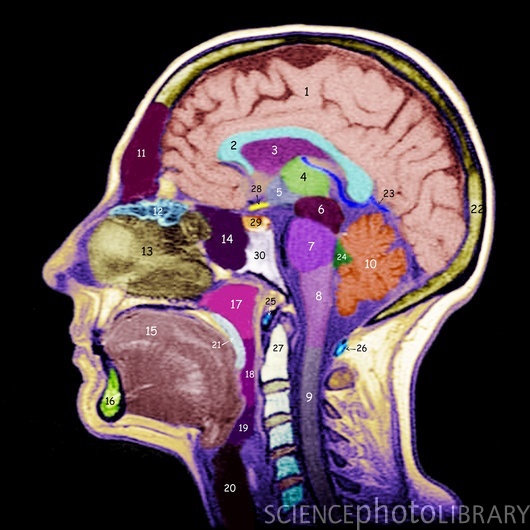Introducing – the Vestibular Nuclei!
This is the next in our series about the balance system and how it should work normally. So far we have talked about the inner ear and how it senses movement, and then we talked about the nerve that runs from the ear to the brain. Today we are going to talk about the brain stem (the base of the brain), and the first step of where the signals go when they enter the brain.

An MRI of the head with the various part of the brain numbered. See the blog post for the relevant bits! (SGO/Science Photo Library)
As I have mentioned in earlier posts, it is important for vertigo and dizziness sufferers to have an understanding of how their balance systems should be working (ie. what normal is), and then to go on and understand why how their systems have failed. The benefits of this are that you can better understand why treatments are applied, how they work, and how long they may take to have an effect. At this point however, the journey of the signals from the ear to their final destination does get a little complicated. But fear not, I’ll make it as simple as possible!
The vestibocochlear nerves from the ear, enter the brain in an area called the cerebellopontine angle, which is a region where the pons (7 on the diagram), medulla (8 on the diagram) and cerebullum (10 on the diagram) meet. The nerves then travel to a group of nuclei (a collection of nerve cells) called the vestibular nuclei. There are four of these nuclei on either side of the brain stem, each with slightly different functions and connections, but for our purposes just think of them as being one. They sit at the back of the brainstem at the join of the pons (7) and medulla (8), in an area called the floor of the fourth ventricle (24 on the diagram).
The nerves also go to a thing called the cerebullum (10). The cerebellum does a number of things, but one of them is to control the actions of the vestibular nuclei, so that they respond in just the right way to the signals they receive – not too much reponse or too little.
So in summary, the nerves from the ear enter the brain at the cerebellopontine angle and then travel to the vestibular nuclei and cerebellum. The cerebellum then controls the vestibular nuclei so they resond in the correct way. What the vestibular nuclei do in their response will be the topic of our next post.
Questions, comments? Please leave a response below. Your feedback helps me give you the information you need. I would love to hear from you.










I have had Vertig now for 4 years On time at year. It last 2 weeks and with apparent causes. Cat scan etc, Blood preassure, ears etc are normal.So in the case of my Vertigo (which is a Symptom) what could cause it and in this case maybe that is a problem between the Vestibular system and ears what is the correct treatment??
Thank you
Hi Igor,
Thanks for your comment. There could be several causes based on the information that you provide. If it is lasting as long as two weeks you may be looking at an infection of the vestibular nerve or the labyrinth. Otherwise without examining you it is hard to say. You should try to find a local vestibular rehabilitation practitioner.
Hope that helps,
Dr Matt
Great, thanks for sharing this blog.Really looking forward to read more. Great.
Leave your response!
Share this blog
Topics
Archives
Tags
Recent Posts
Most Commented